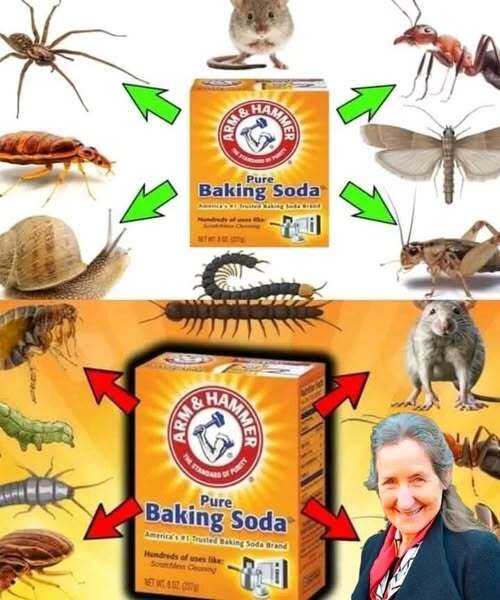Baking soda, a common kitchen staple, is more than just a leavening agent. This versatile substance boasts surprising pest-repelling properties, making it a safe and effective alternative to harsh chemical pesticides.
How Baking Soda Works Against Pests:
- Dehydration: Baking soda absorbs moisture, creating a dry environment that is inhospitable for many pests. This is particularly effective against insects like cockroaches, ants, and fleas, which thrive in damp conditions.
- Disruption of Digestive System: When ingested, baking soda can disrupt the digestive systems of some insects, leading to death.
- Abrasion: The fine, powdery nature of baking soda can irritate the exoskeletons of insects, causing them to dehydrate and die.
Here’s how to use baking soda to combat common household pests:
1. Cockroaches:
- Direct Application: Sprinkle baking soda directly in areas where cockroaches are commonly found, such as behind appliances, under sinks, and in cabinets.
- Borax Mixture: Combine equal parts of borax and powdered sugar. This mixture is highly effective against cockroaches. Sprinkle it in areas where they are seen.
- Bait Traps: Mix baking soda with equal parts of powdered sugar and cocoa powder. Place small piles of this mixture in areas where cockroaches are active.
2. Fleas:
- Pet Treatment: Mix baking soda with cornstarch in equal parts. Sprinkle this mixture on your pet’s fur, gently massage it in, and then brush it out thoroughly.
- Carpet Treatment: Sprinkle baking soda generously on carpets and rugs. Let it sit for at least 30 minutes before vacuuming thoroughly.
- Pet Bedding: Sprinkle baking soda on pet bedding and let it sit for 30 minutes before washing.
3. Ants:
- Trail Disruption: Sprinkle baking soda directly on ant trails. This will disrupt their pheromone trails and deter them from returning.
- Bait Stations: Mix baking soda with sugar or honey to create a sweet bait. Place small piles of this mixture near ant entry points.
4. Moths:
- Clothes Protection: Place small sachets of baking soda in drawers and closets to deter clothes moths.
- Food Protection: Sprinkle baking soda on grains, cereals, and dried fruits to prevent moth infestations.
5. Mice and Rats:
- Repellent: Sprinkle baking soda around entry points and potential hiding places for mice and rats.
- Bait Stations: Mix baking soda with peanut butter to create a bait. Place small amounts of this mixture in bait stations.
6. Spiders:
- Dusting: Dust spider webs and surrounding areas with baking soda. This will irritate the spiders and deter them from returning.
Important Considerations:
- Safety Precautions:
- Wear gloves when handling baking soda for pest control.
- Avoid inhaling baking soda dust.
- Keep baking soda out of reach of children and pets.
- Thoroughly wash hands after handling baking soda.
- Pet Safety:
- If using baking soda on pets, ensure thorough brushing to remove all residue.
- Avoid applying baking soda to open wounds or irritated skin.
- Consult with your veterinarian if you have any concerns.
- Effectiveness:
- The effectiveness of baking soda may vary depending on the severity of the infestation and the type of pest.
- For severe infestations, you may need to combine baking soda with other pest control methods.
- Patience:
- It may take several applications of baking soda to see significant results.
- Be patient and consistent in your efforts.
Additional Tips:
- Cleanliness:
- Maintain a clean and tidy home.
- Regularly clean and vacuum to remove food crumbs and other debris that attract pests.
- Seal cracks and crevices around windows, doors, and pipes to prevent pest entry.
- Natural Alternatives:
- Combine baking soda with other natural pest control methods such as essential oils (peppermint, tea tree, lavender), diatomaceous earth, and neem oil.
- Professional Help:
- For severe infestations or persistent pest problems, consult with a professional pest control service.
Conclusion:
Baking soda offers a safe and effective alternative to chemical pesticides for controlling a variety of household pests. By understanding its properties and utilizing the methods outlined above, you can effectively deter pests and create a healthier, more pest-free home environment. Remember to always prioritize safety and consider combining baking soda with other natural or professional pest control methods as needed.
